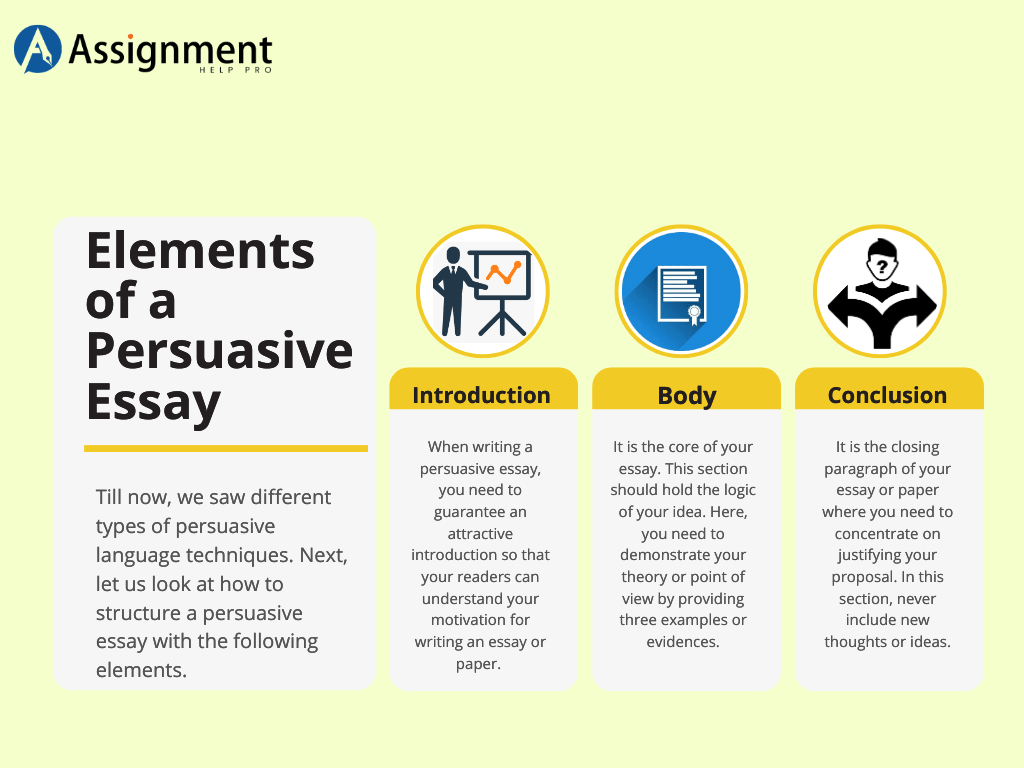Writing an essay is not as simple as it appears. In general, writing is one of the most efficient ways to convey thoughts and ideas about a specific issue. To write an exceptional essay free of faults, you must have good writing abilities and linguistic understanding. Additionally, you must also know how to influence your audience through your writing. In specific, you can use persuasive language techniques or strategies to convince your readers to agree with your views or beliefs.
Are you aware of the different types of persuasive language techniques? Do you know how to use persuasive methods in your essay? If not, continue reading this blog and learn more about persuasive writing.
Also read: 14 Language Techniques Give You 100% Score in Your Assignment Writing
What is Persuasive Writing?
Writing logical arguments with emotional weight in order to persuade readers to adopt a particular viewpoint is known as persuasive writing. It is a crucial writing skill that aids in the structured and convincing presentation of ideas. Both academic and marketing contexts can benefit from persuasive writing.
Sharing one’s opinion is not as straightforward as persuasive writing. In order to persuade your readers, you must employ specific persuasive strategies or methods in your writing.
Various Types of Persuasive Techniques
In general, there are different types of persuasive language techniques available. As a writer, you must be aware of all the persuasive writing techniques and should know how to utilize them at the appropriate places in order to sway your readers.
To help you, here we have shared some important persuasive language techniques that you can use while writing an essay or research paper.
Adjective
It is one of the popular techniques in persuasive writing. Adjectives are describing words that writers most commonly adapt to make the audience feel in a specific way.
Adverbs
Another common persuasive language technique is the adverb. Adverbs are words that modify adjectives or verbs. Like adjectives, the writers also use adverbs to make the audience feel in a particular way.
Appeals
It is a technique often used by writers to touch a different set of emotions. With appeals, the readers’ patriotism, sense of justice, and fairness can be ignited. Some common appealing strategies of persuasion include
Ethos: It is an ethical appeal used to convince the readers about the writer’s credibility.
Pathos: It is an emotional appeal used to persuade the reader by appealing to their emotions.
Logos: It is a logical appeal used to convince the audience with the help of a valid reason or logic.
Alliteration
Alliteration is another persuasive technique that is all about the words that begin with the same sound and because of that similar sound, it creates emphasis.
For example, ‘to hurt individuals so heartlessly delineates Mr.Rufflao to be a rough, brutal, and calculative individual’.
Anecdote
It is a short and personal story used to illustrate a point to the readers.
For example, ‘You know, I had a dog in my adolescence, it was my best friend at that point, and I generally felt that my more youthful days were superb with him’.
Colloquial language
Colloquial language is a kind of informal language that is used extensively in our daily lives while speaking. In order to establish a connection with the readers, many writers use everyday language or colloquial language when writing a persuasive essay.
For example, ‘this episode cracked me out’ versus ‘this occurrence terrified me out’.
Clichés
Clichés are nothing but overused expressions. Actually, it should be avoided, but the writers use them to express their ideas quickly to the readers.
Time will tell, as light as a feather, etc. are some examples of clichés.
Connotations
Connotation is an emotion or an idea carried by a word or a phrase in addition to its literal meaning. Usually, many words have similar meanings but different connotations. The connotation can be positive or negative depending upon its usage. So, in order to create an impact on the reader’s mind, the writers use connotations carefully.
For example, ‘Murder -butcher’, even though both words share a similar meaning, the utilization of butcher will give a superior image of the situation to the reader’.
Emotive words
It is one of the best persuasive techniques used by writers to provoke an emotional reaction from the readers.
For example, to maintain a strategic distance from this danger, we promptly need to take care of the business.
Exaggeration/Hyperbole
In order to emphasize a point and to persuade their opinions to readers, the writers often use extraordinary exaggerations.
For example, “I am so hungry that I could eat an elephant”.
Evidence
Usually, the readers will believe if a point is explained with some evidence. So, the writers use evidence in the form of figures, acts, quotes, or graphs to support their argument.
For example, “According to the World Health Organisation, health is a state of physical, mental and social well-being”.
Expert Opinion
In order to add more value to the argument, the writers use the opinions of experts and easily persuade their readers.
For example, ‘youngsters become more defiant as they go into the phase of high school, says kid clinician Mark Ruffle’.
Logic
A coherent and well-structured argument is persuasive.
For example, if we don’t have adequate assets to address the issues of the expanded people, we can’t proceed with the current migration level. It is clear.
Metaphor
A metaphor is a language technique used to describe one thing as another. The metaphors help the writers to persuade their ideas by describing them poetically to the readers.
For example, “Her life was an exciting ride, everything was topsy-turvy”
Pun
It is a play on words. In order to persuade the readers with wittiness, the writers often rely on homonyms, homophones, or rhymes.
For example, ‘the cardiologist felt detained by his calling. He simply got himself unfit to be free from his bars’.
Repetition
To reinforce an argument and deliver the exact message to the reader, the writers use repetition of words, ideas, and phrases.
For example, ‘we as a whole have endured a great deal previously, and we will keep on affliction if we don’t stop the current government, stop it in states, stop it in gathering, stop it in decisions’.
Rhetorical question
It is an effective persuasive language technique used by the writer. A rhetorical question is a question that has an obvious answer, and it helps the readers to a specific conclusion.
For example, ‘Would we say we are ready to give our kids a world where there is no outside air to inhale, adequate water to drink, and brutality all over the place?’
Sarcasm
Sarcasm is the use of irony to mock someone for humorous purposes.
For example, saying “Very good; well done!” especially when someone does something wrong.
Simile
It is a comparison of two different things using ‘like’ or ’as’. To make a description more vivid and to persuade the readers, the simile is used by the writers.
For example, ‘he is as silly as a lot of monkeys’.
Tone
It is the overall feeling expressed by the entire essay. The tone can be passionate, reasonable, or humorous. You can use any tone depending on your target audience and try to persuade them.
Essential Elements of a Persuasive Essay
Till now, we have seen different types of persuasive language techniques. Next, let us look at how to structure a persuasive essay with the following elements.
Introduction
When writing a persuasive essay, you need to guarantee an attractive introduction so that your readers can understand your motivation for writing an essay or paper. The introduction is an important part of your essay because it acts as the base of the thesis statement for your reader. Your introduction should be simple, clear, and catchy.
Body
It is the core of your essay. This section should hold the logic of your idea. Here, you need to demonstrate your theory or point of view by providing three examples or evidence. Also, in this segment, you should load all the important information and data relevant to your essay or research paper topic. Most importantly, to persuade your readers, you can use any persuasive language techniques and describe your opinions logically and persuasively.
Conclusion
It is the closing paragraph of your essay or paper where you need to concentrate on justifying your proposal. In this section, never include new thoughts or ideas. In order to persuade your point of view to your readers, you should write a convincing concluding statement. Remember to summarize the main points of the essay using persuasive writing strategies.
Tips for Writing a Great Persuasive Essay
We hope you are now clear about the essential elements of a persuasive essay. Next, let us see how to write a persuasive essay effectively.
In order to attract readers using persuasive language techniques, when you write an essay, keep the following tips in mind.
- Choose a topic that matches your interest. You will have a strong opinion and a wealth of knowledge if you choose a subject that you are passionate about. As a result, you will be able to convince your readers with ease given your prior knowledge of the subject.
- Know who you want to reach. By writing the essay in a manner that is appropriate for them, you can easily persuade your target audience and make them believe your ideas if you understand their interests and behavior.
- Grab the attention of the reader with hook sentences. When writing an essay, use a declarative statement to state your position. By beginning your essay with a fact or other piece of evidence that backs up your thesis statement, you can convince your readers. Your readers will believe your concept or agree with your argument if you do this.
- Investigate both sides. Know both sides of your argument if you want to persuade your readers. Your readers might have trouble reaching a conclusion about your ideas or arguments from time to time. At that point, you should be able to persuasively present counterarguments and persuade your audience to concur with your argument.
- Use emotive language. If you present your ideas in a manner that is relatable to your readers, they will believe you. In addition to providing a logical explanation, empathy, and emotive language are essential components of persuasive writing because they target the readers’ sensitivity.
- Make rhetorical inquiries. Asking questions that the readers will be forced to answer is a good way to persuade them.
- Make your point clear. You can use hyperbolic statements to paint a vivid picture for your readers.
- Reiterate the main point. One of the most effective ways to keep your readers’ attention is to repeat the important points.
Final Words
By employing the persuasive language techniques discussed in this blog, compose a persuasive essay or research paper. But, before you begin writing, first have a firm stance on your issue, understand your audience, and then acquire further data to support your position. After conducting research on your topic of discussion, create your persuasive essay with key aspects and express your concept using persuasive language strategies. Remember that the final draft of your argument should be error-free. So, never neglect to revise.
If you find it difficult to compose a persuasive essay, then contact us for assignment help. Our academic writers who are skilled in persuasive writing will assist you in preparing your essay or research paper using the language elements necessary for convincing.
1. What are 5 persuasive techniques?
5 persuasive techniques are retaining trust and developing credibility, aligning with the reader’s perspective, proper language use, correct tone, and use of rhetoric and repetition.
2. What is a common persuasive technique?
A rhetorical question is a very common persuasive technique. Apart from this, alliteration, intonation, metaphor, and simile are also some common techniques.
3. What are the 8 persuasive techniques?
8 widely used persuasive techniques are Attacks, Clichés, Comprehensive Language, Evidence, Exaggeration or Hyperbole, repetition, pun, and humor.







